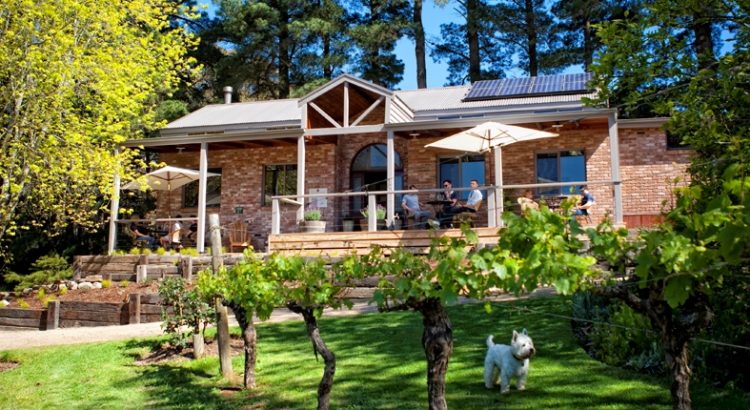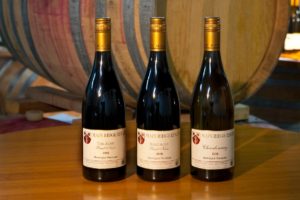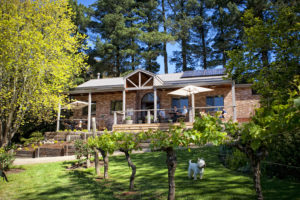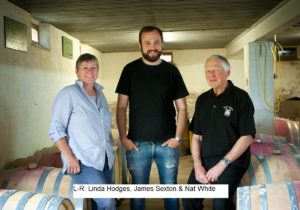Main Ridge Estate. – Pinot without ego.
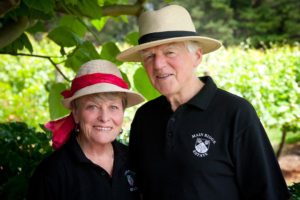
What can you say about Nathaniel (Nat) White and his Main Ridge Estate wines that has not already been said? The quality and character of the former shines through in the latter. Both are inseparable, both are impeccable and both deserve the praise that’s long been bestowed on them.
You sense Australian cool climate pinot noir has come of age when Jancis Robinson describes a Curly Flat as ‘ethereal’ and Mornington Peninsula pinots as ‘particularly crystalline.’ And much credit for this resides in what wine scribe Paul Lloyd calls ‘that fashionable and leathery boot between Western Port and Melbourne’s Port Philip Bay – the Mornington Peninsula.’
Nat would warm to the word leathery, but not the term fashionable.
Pinot noir remains the last frontier of cool climate winemaking, especially on the Mornington and Bellarine peninsulas, in the Yarra Valley, at Drumborg in Henty and Bass Phillip in Gippsland, and in the Macedon Ranges – and of course in Tasmania. Mornington Peninsula wines from Main Ridge Estate, Paringa Estate, Moorooduc Estate and Stonier, to name but a few, vie for pinot supremacy with Tasmanian stalwarts like Kelvedon Estate, Derwent Estate, Home Hill and newcomers like Tolpuddle.
Ask many a winemaker which varietal they would most like to put their name to and it’s invariably pinot noir. And where they would most like to make it? It is Tasmania by a short half head from the Mornington Peninsula.
For a grape that represents less than 4% of Australia’s plantings, pinot noir receives an inordinate deal of attention. It is scrutinised, dissected, evaluated and critiqued to within an inch of its life, likewise those vignerons who seek to master its imponderables.
To appreciate pinot’s ascendency and the Mornington Peninsula’s and Main Ridge Estate’s contribution, a little history first. Pinot noir has travelled widely, but not always well, from its Burgundian home. It has had a chequered career down under however it has come a long way in a relatively short time. Its turbulent travails in Australia have been peppered with heroic failures, misguided romanticism, sheer frustration and endless tilting at windmills that would make Miguel de Cervantes smile.
It’s tempting to see Tom Carson’s Jimmy Watson Trophy success with the 2012 Yabby Lake Block 1 Pinot Noir as a watershed moment, but that’s only the tip of the iceberg, pinot’s successes long pre-date this.
Pinot has enjoyed a long history in the Hunter Valley since its arrival in Australia in 1831. Even the great Morris O’Shea used a modicum of pinot in some of his better wines in the early 1950s, and by the 1980s Hungerford Hill and Rothbury Estate were making palatable pinot. Surprisingly it was the 1976 Vat 6 Tyrrell’s pinot noir’s success at the 1979 Gault & Millau Wine Olympics in Paris, and their 1979 Vat 6 pinot’s gold medal at the 1999 Hobart Wine Show that advanced the cause of pinot no end.
Cool climate pinot enjoyed success in the pre-phylloxera Geelong of the 1840s and subsequently during its renaissance of the mid 1970s and resurgent 1980s. And those who have savoured Gary Farr’s 1984 Bannockburn pinot or a latter-day By Farr Sangereal will attest to this.
The Yarra Valley is no stranger to fine pinot as typified by David Fyffe’s 1984 Yarra Burn, many a Yarra Yering, some Mount Mary, the 2010 Innocent Bystander Giant Steps Sexton Vineyard and recently Paul Bridgeman’s 2013 Levantine Hill.
Not only is Australian cool climate pinot being increasingly well made it’s starting to age well – I enjoyed a 10 year old Main Ridge Estate Half Acre recently.
The genesis of what was to become Main Ridge Estate began in the mid-1960s during the infancy of Australia’s table wine when Nat and Rosalie White visited Château Pommard in Pommard, Burgundy in mid-winter. That they were able to gain admittance to Pommard’s barrel tasting room was because the cellar master liked the look of the young Rosalie. That the creation of Main Ridge Estate hung on such a serendipitous moment makes Nat chuckle to this day.
That it was in the Pommard commune is equally as romantic in that it evokes memories of that 19th Century Yarra Valley pioneer Paul de Castella’s salutation that a Yering red ‘was better than Pommard!’ Two vinous pioneers over a century and a half apart with a love of Pommard.
Camelot, in the guise of Main Ridge Estate came to the Mornington Peninsula in 1975 when, for the princely sum of $25,000, Nat and Rosalie brought a 5 hectare site with no road access. With the help of the Department of Agriculture’s Geoff Godden, they set about planting cabernet sauvignon, pinot noir, pinot meuniere, riesling, traminer and chardonnay. ‘As the Main Ridge climate seemed to be half way between that of Bordeaux and Burgundy, initially I was unsure which varieties would suit best’ says Nat.
At first Nat’s cabernet sauvignon showed promise with the success of the 1982 Main Ridge Estate cabernet at the 1983 Lilydale Show. It also won the St Hubert’s Award and the Victorian Wine Center Trophy for the best red. Significantly a 1983 pinot won a gold medal at the same Show. Back then it was hard to get your hands on a Mornington Peninsula cabernet or pinot, few Melbourne retailers or restaurants sold them, aside from Fanny and Two Faces.
Nat’s success with the 1982 cabernet proved a somewhat pyrrhic victory in that it distracted him from focusing on pinot, wisely he eschewed entering wine shows ever since. Suffice to say Burgundy prevailed over Bordeaux and the rest is history.
Ah, but what a wonderful history as evident in many an Acre and Half Acre pinots from 1986 and 1992 through to 2004 and beyond, culminating in stellar 2013 and ‘14 vintages. Alas too few of which were drunk by this writer. Then there are the silky chardonnays of 1986 and 1989 and of most every vintage from 2000 onwards. Enough said!
Any account of Main Ridge Estate would be incomplete without reference to Huon Hooke’s perceptive observation that ‘Nat is not too proud to tell a story against himself. At the recent Mornington Peninsula Pinot Noir Celebration, he mentioned famous Melbourne restauranteur Hermann Schneider (of Two Faces) had bought a case of his first wine, made from cabernet sauvignon, a grape which today is thought quite unsuited to the peninsula.’
‘Years later, Schneider offered to sell what remained of it back to Nat. When the box arrived, there were still 10 bottles in it. One had been tasted by Schneider, the other was the only bottle ever bought by a customer!’ I may well have been the one who bought it as I remember drinking a Main Ridge Estate red or two at Two Faces!
Nat’s Half Acre pinots show the inherent quality and finesse of single vineyard, site specific Mornington Peninsula wines at their best. As the ebullient Melbourne retailer Phil Hude says ‘Nat is special in that he has been able to extract greatness from the plot, much like Rick Kinzbrunner did at Giaconda.’
As to how Nat achieved this is encapsulated in his philosophy of ‘grown and made entirely on the estate, quality entirely uncompromised by any expectation of quantity’. ‘My aim has always been to first make fault-free wine, then to use my accumulated experience to deliberate on complexity’ says Nat.
Sublime wines aside, part of Main Ridge Estate’s cellar door appeal is its relative inaccessibility. It’s off the beaten track – like sourcing its wines you have to make an effort to visit the vineyard, but once you do you are well rewarded and always receive a warm welcome. Rosalie’s weekly lunches featuring aged Main Ridge Estate pinots were extremely popular.
I would have given anything to have been at the 2015 Mornington Peninsula International Pinot Noir Celebration and savored the moment when Nat announced his plans to sell Main Ridge Estate, which he subsequently did to the Sexton family. No doubt there would scarcely have been a dry eye and many a lump in the throat in recognition of a couple so well loved by so many for so long, especially the likes of Eldridge Estate’s David Lloyd, Paringa’s Lindsay McCall and Paradigm Hill’s George Mihaly.
New winemaker James Sexton has big shoes to fill. Fortunately he has assistant winemaker Linda Hodges by his side and Nat looking over his shoulder. Of Nat as a mentor James says ‘’There is no such thing as a silly question. He is always happy to hear your point of view before giving you the appropriate solution and explaining why – even though he is much older, he is still accepting of new thoughts and ideas.’
I’m reminded of what Shaw + Smith’s talented winemaker Adam Wadewitz said of Viv Thomson on Best’s Great Western’s 150th birthday this year ‘ Viv is one of the best winemakers on the planet, but he is a much better bloke than he is a winemaker.’
He could just as easily have been talking about Nat White.
(Originally published in Edition Seven of Alquimie.)
